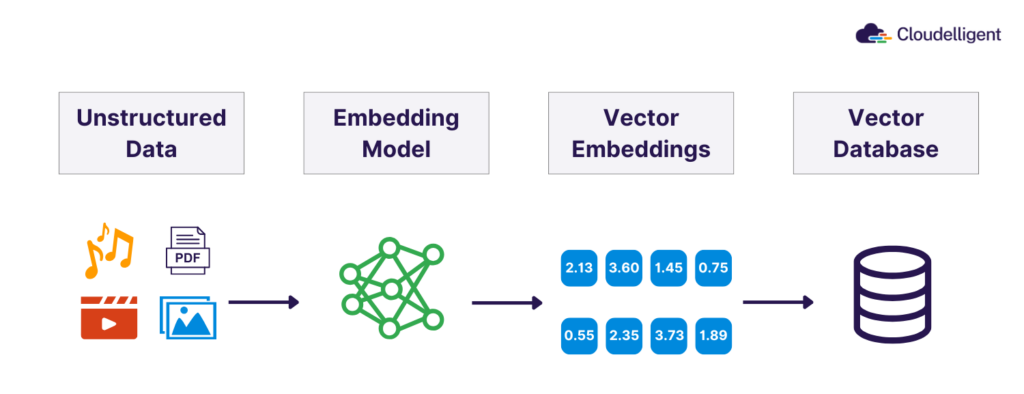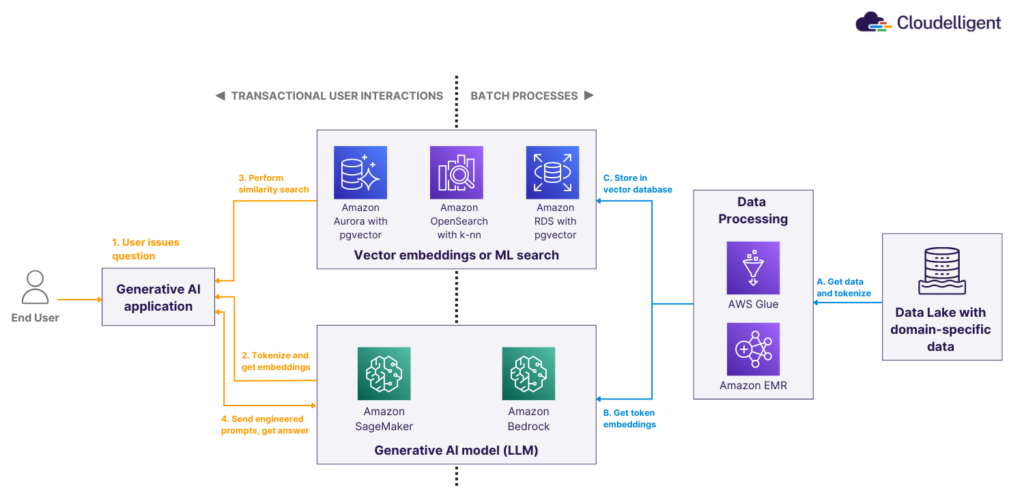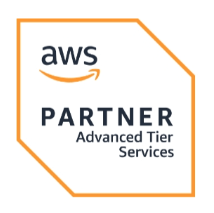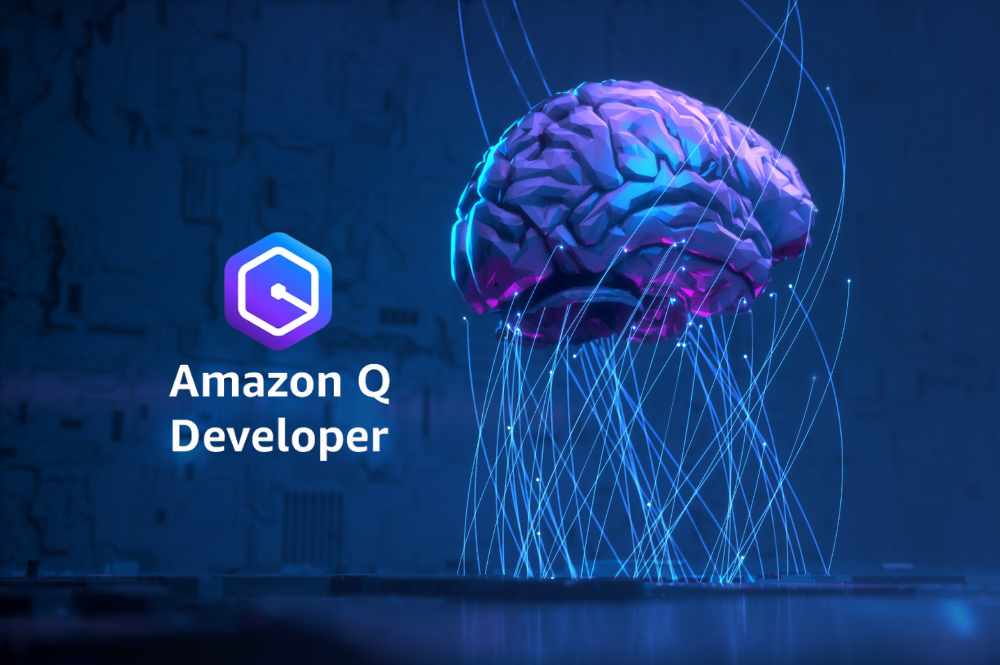Generative AI is driving a new era of innovation, empowering businesses to automate tasks, craft unique products, and derive profound insights from vast amounts of data. According to recent projections, the North American Generative AI market is projected to expand at a compound annual growth rate (CAGR) of 19.1%, reflecting its transformative impact across various industries. Globally, the Generative AI market is expected to grow at an even faster rate, with a CAGR of over 30% in the coming years.
Yet, many companies struggle to move beyond the initial stages of implementing Generative AI solutions, facing data complexity and scalability issues. Overcoming these obstacles requires not just the right technology, but also the expertise to implement and scale it effectively. Vector databases, a powerful tool for storing and retrieving large amounts of unstructured data, can help businesses overcome these challenges. By leveraging these databases, businesses can optimize their AI models. These would ensure faster and more efficient data processing while scaling AI-driven applications for long-term success.
In this blog, we’ll explore how vector databases are reshaping the Generative AI landscape and emerging as a powerful force for advancing the future of AI.
Why Are Vector Databases Essential for Generative AI Success?
Many businesses encounter challenges in their Generative AI initiatives due to their reliance on traditional databases. These databases, primarily built for structured data and exact-match queries, struggle with the complex and unstructured data essential for Generative AI. Common issues include slow data retrieval, difficulties in managing unstructured data like text and images, and limited similarity search capabilities. As a result, these shortcomings hinder the speed, accuracy, and scalability of Generative AI models, preventing businesses from fully leveraging AI innovations.
Vector databases, however, overcome this challenge by efficiently managing unstructured data and embeddings which enable fast and relevant data retrieval. This ensures your organization can scale AI models effectively without the usual performance lags and bottlenecks of traditional databases.
What Exactly Are Vector Databases?
Vector databases represent a cutting-edge approach to data management. They are specifically designed to store and retrieve high-dimensional data as vectors. Unlike traditional databases focused on structured data like numbers or text, vector databases handle complex types like images, audio, and unstructured text by using embedding models to transform them into meaningful vectors.
Vector databases open the door to innovative experiences such as using a smartphone photo to find visually similar images. It allows for the delivery of nuanced, context-aware search results—vital for Generative AI applications that rely on understanding data relationships. Such capabilities are essential in AI-driven tasks that demand similarity searches, including recommendation engines, personalized customer interactions, and real-time decision-making.
Additionally, vector databases play a key role in Generative AI workflows, particularly in processes like Retrieval Augmented Generation (RAG). RAG is a process used to enhance prompts in Generative AI. It retrieves relevant information from knowledge bases, such as internal databases or data stores, that contain domain-specific data. The data is then incorporated into the prompt to provide up-to-date, accurate, and contextually relevant information.

Figure 1: How Vector Databases Work
RAG helps enrich the prompt by appending domain-specific knowledge, improving the model’s output. Traditional queries can retrieve personalized data, such as user profiles that provide situational context. In contrast, vector databases retrieve semantically similar data that enable more precise and relevant prompts for AI applications.
You can also use embeddings to improve the accuracy of your Generative AI application. The following diagram illustrates this data flow.

Figure 2: Using Vector Databases for RAG
In fact, AWS offers a suite of services designed to support and optimize vector databases for seamless AI integration, such as:
- Amazon OpenSearch Service: Supports k-Nearest Neighbor (k-NN) search, allowing users to efficiently find similar items in high-dimensional vector data. This makes it ideal for applications that require real-time recommendations and search functionality.
- Amazon MemoryDB: Offers high-performance vector search capabilities, allowing organizations to store and retrieve millions of vectors with single-digit millisecond response times. This speed is crucial for applications requiring rapid response and scalability.
- Amazon DocumentDB (with MongoDB compatibility): Supports vector search, enabling the storage, indexing, and efficient querying of millions of vectors. This simplifies the integration of vector data with document-based applications and enhances machine learning workflows.
- Amazon Neptune ML: Utilizes Graph Neural Networks (GNNs) to analyze graph-based data as vectors, facilitating the modeling of complex relationships. This enables faster, more accurate predictions for applications that rely on interconnected data points.
How Vector Databases Are Transforming Data Management and Generative AI
In the age of technological revolutions, vector databases are emerging as game-changers for businesses looking to harness the full potential of Generative AI. Below are just a few examples of how they are transforming the digital landscape.
- Enhanced Search and Retrieval: Vector databases allow for similarity-based search. For example, if a user uploads an image to find similar ones, vector databases analyze the vectors of the image. It compares it to others and retrieving the closest matches.
- Improved Machine Learning Models: Vector databases streamline the process of feeding vast amounts of unstructured data (such as images, videos, and text) into ML models making them more accurate and responsive
- Seamless Integration with Big Data and AI: Whether handling millions of data points from IoT devices or managing vast datasets vector databases process and analyze data faster which makes it easier for your business to stay agile.
Leveling Up Your Generative AI Applications With Vector Databases
Vector databases bring several advantages to AI and real-time analytics:
- Scalability: As data grows, vector databases handle vast amounts of unstructured data without compromising on speed.
- Speed and Accuracy: Their ability to perform rapid similarity-based searches enhances the performance of AI models, leading to faster and more precise decisions.
- Handling Unstructured Data: Traditional databases struggle with unstructured data like images and text. Vector databases thrive on it, making them indispensable for modern AI applications.
- Cost-Effectiveness: Vector databases reduce the need for extensive data preprocessing while optimizing resource use and lowering operational costs.
With these advantages, vector databases not only enhance the capabilities of generative AI but also pave the way for more innovative and efficient solutions in a rapidly evolving digital landscape.
Key Use Cases Across the Industries
Vector databases are becoming increasingly valuable across various sectors, including financial services, healthcare, and nonprofit organizations. Here’s how they contribute in each of these areas.
- Financial Services: Vector databases enable financial institutions to analyze large datasets rapidly and identify unusual patterns that may indicate fraud. By processing high-dimensional data such as transaction histories and customer behavior. These databases enhance the detection of anomalies and improve risk management strategies.
- Healthcare: Techniques from video and image processing are highly effective in analyzing medical diagnostic scans, like MRIs and X-rays. By transforming these images into vectors, they can be compared against extensive databases of known conditions. This approach uncovers patterns that may go unnoticed by the human eye, aiding in accurate diagnoses. Consequently, doctors can identify early signs of cancer and other severe illnesses without the need for invasive tests.
- Nonprofit Organizations: Vector databases enable nonprofit organizations to analyze and manage large data sets efficiently. They enhance decision-making with improved data insights, boost donor engagement through preference analysis, and streamline resource allocation using data-driven strategies. Moreover, they can support ML models for predicting trends, enhancing outreach, and tailoring programs to community needs. This ultimately leads to more impactful outcomes.
As these examples illustrate, vector databases are transforming data management and analysis across diverse industries. Cloudelligent’s recent work with a nonprofit organization demonstrates how harnessing these advanced databases can elevate data infrastructure, optimizing both precision and performance.
Our team empowered a nonprofit by modernizing its data infrastructure with Amazon OpenSearch Service as a vector database. This strategic enhancement unlocked advanced search and analytics capabilities, elevating the scalability and relevance of their services. With Cloudelligent’s expertise, the nonprofit harnessed vector databases to significantly improve search precision and performance. It helps ensure that their AI models had fast access to relevant, real-time data. This integration allowed them to manage high-dimensional data effortlessly. It delivers quicker and more accurate insights that were crucial for supporting their investment strategies and driving impactful outcomes.
Future-Proof Your Generative AI Applications With Cloudelligent
As 2024 unfolds, vector databases are not just keeping pace with AI advancements—they’re leading the charge. With businesses facing an ever-increasing influx of data, vector databases have emerged as game-changers in real-time analytics. Their speed, scalability, and ability to handle unstructured data enable organizations to uncover deeper, actionable insights instantly. For companies aiming to stay ahead in this data-driven era, adopting these innovations is no longer optional—it’s essential.
At Cloudelligent, we offer Data Acceleration Workshops that provide strategic guidance and hands-on experience. These would allow you to leverage vector databases and AWS services for your Generative AI applications. Our workshops include the following key components:
- Strategic Road-mapping for Gen AI: We work with your team to identify business opportunities for AI and create a tactical roadmap leveraging AWS services.
- Data Acceleration Assessment: We help evaluate your current data infrastructure and ensure its capable of supporting the high-dimensional data required for Generative AI applications.
- Data Architecture Design on AWS: Our experts collaborate with you to ideate, design, and plan out a future-state architecture for Generative AI tailored to your business needs.
- Data Blueprint for AI Innovation: We present an actionable roadmap for implementing a modern data architecture on AWS for AI Innovation.
As technology continues to advance at an unprecedented pace, adapting to new innovations is crucial. Consider upgrading your data infrastructure for the AI-driven future. Our experts over at Cloudelligent are ready to help you unlock the full potential of vector databases and Generative AI applications. Contact us today for a Free Data Acceleration Assessment and see how we can transform your data strategy with cutting-edge solutions on AWS.










